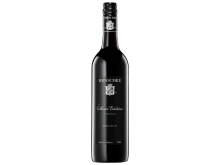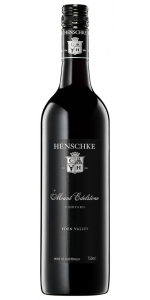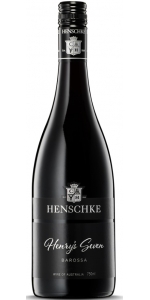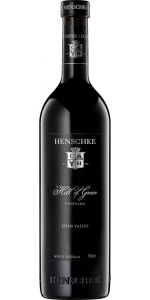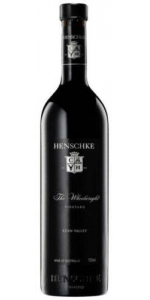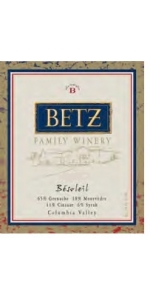Henschke Mount Edelstone 2015
| Country: | Australia |
| Region: | Eden Valley |
| Winery: | Henschke |
| Grape Type: | Shiraz |
| Organic: | Yes |
| Vintage: | 2015 |
| Bottle Size: | 750 ml |
Henschke Mount Edelstone is made from 100 percent Shiraz.
Deep crimson with violet hues. Fragrant, spicy aromas of black pepper, sage, bay leaf and anise are interwoven with vibrant Satsuma plum, blackberry and blueberry, and gentle tarragon and cedar notes. The palate is complex and textured with rich and concentrated flavours of mulberry, blackberry and Satsuma plum, layered with sage, black pepper and star anise. The finish is beautifully balanced, with long, velvety tannins and excellent depth.
The beautiful and historic name Mount Edelstone is a translation from the German Edelstein meaning ‘gemstone’, a reference to small yellow opals once found in the area. The Mount Edelstone vineyard was planted in 1912 by Ronald Angas, a descendant of George Fife Angas who founded The South Australian Company and played a significant part in the formation and establishment of South Australia. Unusual for its time, the vineyard was planted solely to shiraz. The ancient 500-million-year-old geology in the vineyard has given rise to soils that are deep red-brown clay-loam to clay, resulting in low yields from the dry-grown, ungrafted centenarian vines. First bottled as a single-vineyard wine in 1952 by fourth-generation Cyril Henschke; by the time Cyril purchased the vineyard from Colin Angas in 1974, Mount Edelstone was already well entrenched as one of Australia’s greatest shiraz wines. Crafted by the Henschke family for over 60 years now, Mount Edelstone is arguably the longest consecutively-produced, single-vineyard wine in Australia.
Review:
Kaleidoscopic, this glorious vintage is terroir translucent, transporting you to the vineyard with its signature aromas of dried sage, Eucalyptus olida (aka Strawberry Gum), wild mint, wattleseed, nutmeg and tinder. Soaring and super-expressive, these scents bring compelling dimension and meld exquisitely on the sweet, juicy plum and bramble palate, with its cocoa nib and earthy hints. Graceful, willowy tannins and mineral acidity make for a long, fluid, markedly perfumed finish. Irresistible already!
-Decanter 98 Points
Henschke Henry's Seven Red Blend is made from 72% Shiraz, 13% Grenache, 12% Mataro, 3% Viognier.
20th ANNIVERSARY VINTAGE
Deep ruby with violet hues. Lifted raspberry, red currant, mulberry and Satsuma plum, with floral notes of violets, lavender, crushed flowering herbs and anise, pepper and mace spice. A rich and intense palate of well defined, concentrated red fruits; red currant, cut plum and spicy wild berries, give way to crunchy mid palate, firm-edged velvety tannins and excellent length.
Review:
Aromas of black fruit and green tobacco with bark and wet-earth undertones, following through to a medium to full body, creamy tannins and a juicy, savory finish. Intense and balanced.
-James Suckling 95 Points
Dark crimson in color, with deep garnet hues. A concentrated array of aromas of mulberry, blackberry and dark plum indicate the richness to come, while savory and complex notes of charcuterie, cedar, sage and five spice tease the senses. Plush and velvety on the palate, the wine has intense fruit concentration with plum, red currant, blackberry and anise flavors, yet an enchantingly elegant and refined structure. Layers of silky tannins reveal the impressive depth of the wine before giving way to an incredibly long finish.
Review:
This has a very complex nose, offering so many facets of spices and fragrance with florals and orange peel, as well as crushed stones, ripe black cherries, blackberries and dark cherries, earth, chocolate and more. The intensity and power here is very tightly held and it has a build of such precise tannins, which carry very intense and assertively ripe blackberries, dark cherries, ripe plums and blueberries. So much on offer here. This has a very bold, intense feel. Exceptional vintage. One of their finest. Try from 2028.
-James Suckling 100 Points
Dark crimson in color, with deep garnet hues. A concentrated array of aromas of mulberry, blackberry and dark plum indicate the richness to come, while savory and complex notes of charcuterie, cedar, sage and five spice tease the senses. Plush and velvety on the palate, the wine has intense fruit concentration with plum, red currant, blackberry and anise flavors, yet an enchantingly elegant and refined structure. Layers of silky tannins reveal the impressive depth of the wine before giving way to an incredibly long finish.
Review:
A rather refined Hill of Grace with roasted meat, smoked meat, and juicy plums. Some mushroom and forest-flower character, too. It’s medium- to full-bodied, juicy and savory. Light white pepper at the end. Underlying finesse and elegance to this. The flavor does not go away. From biodynamically grown grapes. Drink or hold.
-James Suckling 99 Points
Medium garnet with crimson hues. Intense and evocative aromas of briary black currant, blackberry, blueberry, Satsuma plum, with lifted notes of sage, bay leaf, crushed flowering herbs, black pepper, anise and hints of cedar. The palate is rich and complex with well-defined blackberry, mulberry, red plum and black currant fruit, layered with sage, black pepper and bay leaf, and carried by fine-grained, mature, velvety tannins for an almost endless finish.
Pair with Lamb Loin.
Review:
A juicy and savory red with plum, chocolate, hazelnut, and walnut aromas and flavors. Medium to full body and creamy tannins. Juicy and balanced. Meat and chocolate. Molé-like. From biodynamically grown grapes. Drink or hold.
-James Suckling 96 Points
Blending Detail:
- 49 % Grenache
- 20% Syrah
- 16% Cinsault
- 9% Mourvêdre
- 6% Counoise
Grenache speaks loudly in the Bésoleil with notes of pomegranate, red raspberry, and strawberry leaf. The Counoise and Cinsualt bring bing cherry fruit and blueberry notes to the table, complicated by pepper and garrique. Mourvedre donates a wild meatiness to the blend, and a purple hue. Syrah rounds things out, adding texture, and flesh to the palate.
Review:
The first vintage where they’ve pushed the bottling back to give the cuvee 16-18 months in barrel, the 2015 Besoleil is a dead ringer for a high-quality Chateauneuf du Pape and offers perfumed notes of herbes de Provence, kirsch, licorice and sweet spice. It’s medium to full-bodied, textured and fruit-forward, with a hedonistic yet elegant profile that’s going to evolve gracefully.
Robert Parker 91-93 Points
Henschke Mount Edelstone is made from 100 percent Shiraz.
Deep crimson with violet hues. Fragrant, spicy aromas of black pepper, sage, bay leaf and anise are interwoven with vibrant Satsuma plum, blackberry and blueberry, and gentle tarragon and cedar notes. The palate is complex and textured with rich and concentrated flavours of mulberry, blackberry and Satsuma plum, layered with sage, black pepper and star anise. The finish is beautifully balanced, with long, velvety tannins and excellent depth.
The beautiful and historic name Mount Edelstone is a translation from the German Edelstein meaning ‘gemstone’, a reference to small yellow opals once found in the area. The Mount Edelstone vineyard was planted in 1912 by Ronald Angas, a descendant of George Fife Angas who founded The South Australian Company and played a significant part in the formation and establishment of South Australia. Unusual for its time, the vineyard was planted solely to shiraz. The ancient 500-million-year-old geology in the vineyard has given rise to soils that are deep red-brown clay-loam to clay, resulting in low yields from the dry-grown, ungrafted centenarian vines. First bottled as a single-vineyard wine in 1952 by fourth-generation Cyril Henschke; by the time Cyril purchased the vineyard from Colin Angas in 1974, Mount Edelstone was already well entrenched as one of Australia’s greatest shiraz wines. Crafted by the Henschke family for over 60 years now, Mount Edelstone is arguably the longest consecutively-produced, single-vineyard wine in Australia.
Review:
A very profound sage note here with wild brambleberries, bay leaf and subtle oak influence, cast across a green-peppercorn and mint-tea nuance with such bright red berries and plums. The palate has a super plush and elegant shape and fine, velvety-tannin texture with plush, long red plums. Such poise and elegance with length and concentration here. An exceptional vintage for Mount Edelstone. Drink or hold.
James Suckling 96 Points
Super intense blackcurrant and spice on nose. The palate is laden with dried fruit, figs, dates and Christmas cake notes. Incredibly ripe fruit but combined with lovely freshness and balance. This is a big wine but holds all its components well and perfectly demonstrates this style of wine. RS: Open and bright red fruits, crunch raspberry and cherry with dark bramble, blackberry and fig. Slight menthol mintiness. Complex, lifted and interesting nose, meaty bacon bbq nose. Fine well balanced and elegant palate, good tannic structure, fine long and velvety. Well balanced refined palate with balanced alcohol. BW: Super intense blackcurrant and spice on nose. Palate is laden with dried fruit, figs, dates... christmas cake. incredibly ripe fruit but combined with lovely freshness and balance. This is a big wine but holds all its components well and perfectly demonstrates this style of wine. AH: Warm, spicy, juicy, black fruit dominated Syrah. Loads of density here. A lovely example with plenty of interest on both the nose and palate. Has an appealing slight mintiness on the finish which keeps the palate fresh. Juicy, full and fleshy. An appetizing, Syrah. Fine and with good ageing potential.
-Decanter 96 Points
Henschke is one of Australia’s leading winemakers and grapegrowers. Henschke is recognised for its rich heritage, innovative spirit and commitment to handcrafting exceptional wines for 150 years. The Henschke family’s grapegrowing and winemaking tradition spans six generations, from outstanding sustainable vineyards in Eden Valley, Barossa Valley and the Adelaide Hills. The small-medium wine business has an annual crush of 700 tonne and employs around 50 staff. Prue Henschke manages the 105 hectares of vineyard, spanning from Eden Valley to Lenswood in the Adelaide Hills wine region.
Stephen and Prue continue to craft their white wines with a focus on purity, while their red wines have a strong focus on terroir, using traditional winemaking techniques.
“Prue and I are the current ‘keepers of the flame’. Just as earlier generations have done, we want to manage the vineyards and winery so they can be passed on to the next generation in better condition than we inherited them. The last 50 years have been an incredible journey for the Australian wine industry. Hill of Grace and Mount Edelstone are arguably the two oldest single vineyard wines produced in this country that tell the wine story of Australia. Our vision would not be complete without the expectation that future generations will uphold and perpetuate our belief that such ancient and unique single-vineyard sites can produce exceptional wines that are prized for their beauty and rarity.”
Stephen has retained the traditional approach to red winemaking used by his forebears. They handled the wines gently; used minimal racking, low sulphur, gentle fining and filtration, unlike what is so often done today for ‘cosmetic’ reasons. Stephen’s forebears took a puristic, holistic approach that had been passed down from generation to generation so it was almost intuitive. At the ’50 Years of Hill of Grace’ celebration in 2008 when Stephen tasted every vintage – some for the first time – he was struck by how closely he was emulating his father’s winemaking of the late 1950s and the 60s with his minimal intervention techniques.
With today’s advanced viticultural practices, of course, the greatest focus is given to the quality of fruit in the vineyard. And just as success of the reds is largely attributed to fruit quality, so too is the quality of the whites.
If Stephen shows a traditional influence with red winemaking, then it is true to say he has been influenced by his German studies for the whites. In a way he is using the best of Old World tradition coupled with New World technology. He retains a purity of fruit through careful handling of the juice and wine, which brings out the intense, varietally pure perfumes of the natural grape flavours. Combine this with the today’s technology – and taste the resulting whites – and it is clear that Stephen has created a new direction for Henschke that his forebears could never have imagined. In recent years they have welcomed next-generation family members into the business. Their son, Johann, has carried on the family winemaking tradition in his capacity as winemaker and viticulturist since 2013, as the fifth and sixth-generations transition through this important period of the transfer of knowledge, skills, and traditions.
With many of the challenges for the next generation already well-documented, Johann expects that innovation and careful strategic planning will be crucial tools for him and his peers to utilise. Above all, continuing on the traditional winemaking techniques which the Henschke family have used for generations, and ensuring that the Henschke continues to be nurtured in the same prudent way that it has always been, will allow it to be passed on to successive generations and to be held in the same high regard as it is today.
- back
Far Niente Napa Valley Cabernet Sauvignon is made from 92.3% Cabernet Sauvignon, 6% Malbec, 2% Cabernet Franc, 1.7% Petit Sirah, 1% Petite Verdot.
Beautiful aromas of dark plum, red cherry, licorice and warm baking spices open onto a plush and silky palate layered with plum, spiced cherry and cassis. A classic Napa Valley Cabernet, fine-grained tannins and lively acidity support the wine throughout, while the finish is refined and polished.
Review:
Made with grapes sourced from Rutherford, Calistoga, St. Helena, and the winery's home in Oakville that aged 17 months in French oak, this impeccably balanced and complex red is as elegant as it is emotive. Blackberry and clove-spiced cedar line the mouth, erupting with graphite and espresso. Finely grained tannins adhere to dusty plum and lavender.
-Tasting Panel 97 Points
Refined and pure aromas of dark cherries, blackcurrants, violets and cedar. The palate is full-bodied with seamlessly integrated tannins and focused acidity, giving notes of Damson plums, graphite, mocha, dried herbs and potpourri. Very well balanced and polished.
-James Suckling 96 Points
Bertani Valpantena Amarone is made from 80% Corvina Veronese, 20% Rondinella.
The best grapes are selected so that only the healthiest and ripest bunches are sent to the drying rooms in the historic winery at Grezzana, where they are laid out in single-layer crates. In mid- January, the grapes are destemmed and crushed, then fermentation starts, at first at a temperature of 39°F- 41°F, which then reaches 72°F in the final stages.
WINEMAKING
The vines are vertical-trellised and Guyot-trained, with a planting density of 2024 plants per acre. Hand harvest is carried out in the middle of September.
This amarone is produced in the Valpantena hills, north of Verona. The soils are calcareous-marl in the east and calcareous-clay in the west, rich in iron.
TERROIR & VINTAGE NOTES
Bertani’s impact on Veneto wine making, particularly in Amarone production, is so considerable that ‘Bertani’ and ‘Amarone’ are nearly synonymous. Their 150+ year history is dotted with groundbreaking initiatives and royal accreditation. While respectful of their past, Bertani strives towards innovation, using progressive techniques and equipment allied with extensive experience and a deeply felt respect for tradition to provide wines of uncompromising quality.
On the nose, marked and intense aromas of very ripe cherries, sour cherries, spicy and nutty notes typical of the Valpantena. Good follow-through of red fruits on the palate, with supple tannins to give depth. This full bodied wine pairs well with rich dishes, mature cheeses and strong-flavored meats.

